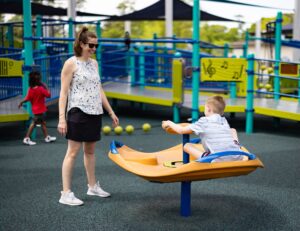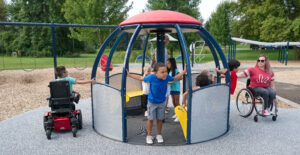Photo: Moore has worked on projects of all sizes across the country for schools as well as communities, including the world’s largest inclusive playground, Park Circle in Charleston, S.C. | Photo Credit: Courtesy of Landscape Structures
By Lindsey Coulter

Photo Credit: Courtesy of Landscape Structures
Jill Moore is an inclusive play specialist with Landscape Structures, a playground manufacturer based in Delano, Minn. She is also a wheelchair user who uses her lived experiences to help develop more innovative, informed and inclusive playground designs. Or rather, she’s used her childhood experience of not being able to access and enjoy most playgrounds to be an advocate for spaces that welcome all.
“When we build for inclusion, we’re saying who we value,” Moore said. “When I see an inclusive playground, I feel welcome there. Someone has thought of me and decided that I matter and have something to add.”
Moore has worked on projects of all sizes across the country for schools as well as communities, including the world’s largest inclusive playground, Park Circle in Charleston, S.C. She helps clients to consider play structures and equipment as well as who they are designing for and what play opportunities would best align with their community’s needs.
Moore spoke with School Construction News about what makes for a successful project, how clients can shift their approaches to make spaces even more welcoming and the common recommendations that can help any play space be more inclusive.
Is there a general definition or criteria for what makes a play area or play equipment accessible and inclusive?
Moore: Yes and no. The ADA guidelines for children’s play spaces were written in 2000, and in 2010 those guidelines became law, but they are the bare minimum. We’ve never really defined inclusion with a check box, because as soon as you give it a check box people adhere to the minimum. For example, inclusive playground design for me could look very different from inclusive design for a child with autism. While there is no official governing body that is giving a stamp of approval, there are a ton of best practices that designers can use to make a playground inclusive.
Historically, how have play spaces inadvertently excluded children with disabilities?

Photo Credit: Mike Bigalke
Mike Bigalke
Moore: Even after ADA compliance you could go to an ADA-compliant play space, and someone like me wouldn’t necessarily be able to do anything on that playground. For example, Engineered Wood Fiber is considered “accessible”, but maneuvering a wheelchair through it is impossible, as loose-fill materials are hard to push through. So, it’s considering how a kid moves through a space; if they use their energy just to navigate the playground rather than actually playing on it. It’s considering children who use mobility devices, but it goes much further. For example, playgrounds are usually loud, busy places with lots of sensory stimulation and sometimes complex play components that require a lot of motor coordination. This could exclude kids with autism or ADHD who are easily overstimulated, are working on their motor coordination or are developing those skills at a different pace.
Why is it important to shift away from the medical model of disability and toward the social model?
Moore: The medical model of disability puts all the fault on the user. If we build exclusively, we’re saying ‘It’s your fault you can’t access this due your needs and abilities being different or more complex.’
In the social model, however, we’re saying it’s the environment that needs to change so that you can be your best self. When I was a kid I hated the playground, but there was a massive difference between my peers not wanting to play with me and me not being able to play. The social model says everyone is meant to be here; it doesn’t blame anyone or call them out for whatever their needs may be.
How can inclusive play spaces benefit all users?
Moore: It’s hard to pinpoint what “inclusive” means because everyone needs different things. When you say “inclusive design” most people assume that means designing for people with disabilities, but we’re designing for everyone because play is important for everyone. That’s where we learn fundamental cognitive, physical, sensory and social skills. When we climb on things, use our muscles, run around, push on things—which are all so inherent to play—we are developing sensory systems that allow us to also do things like cut construction paper, open doors and communicate. When we spin or swing or engage in motion, we’re developing our sense of movement and bodily awareness. We need those fundamentals if we’re going to be successful with day-to-day life and activities.
What are some immediate and cost-effective ways that clients can redevelop or renovate existing play spaces to be more inclusive?
The best thing to do is get a clear understanding of who you’re designing for and who you are serving. You might not need to spend money on a ramp if your ability demographic isn’t as focused on physical disabilities, but you could include a climbing device with different skill-level routes that would meet a variety of needs—or a spinner to provide regulation for a child who seeks out that sensory experience.
Anchorage Alaska’s State of Play initiative is a helpful example. It’s a methodology for becoming a more inclusive park system that rated all public parks, Level 1 is the most inclusive and Level 4 is for play spaces that didn’t even meet ADA standards. They tackled the list over time, and from 2006 through now, they’ve become a really inclusive parks system through retrofits, phasing, adding inclusive features as budget allows, etc.


